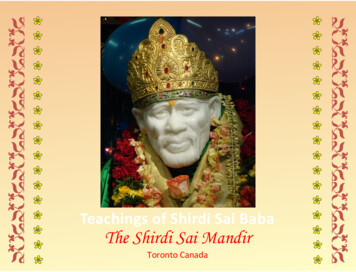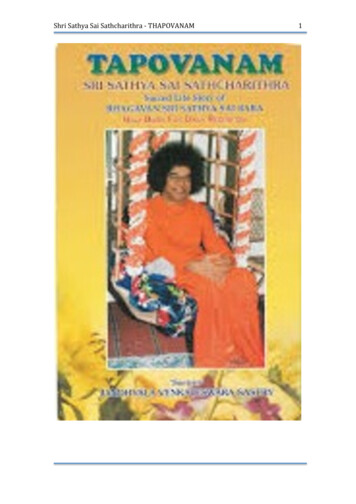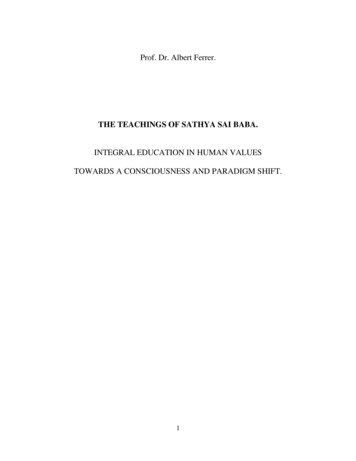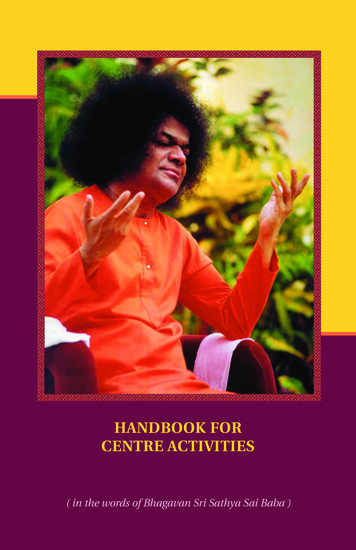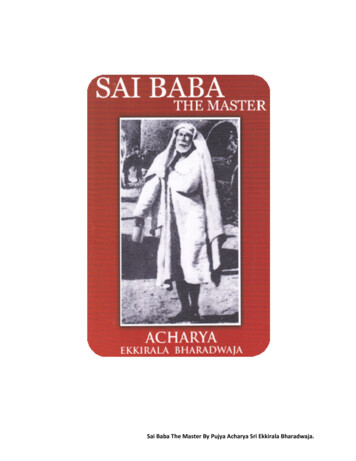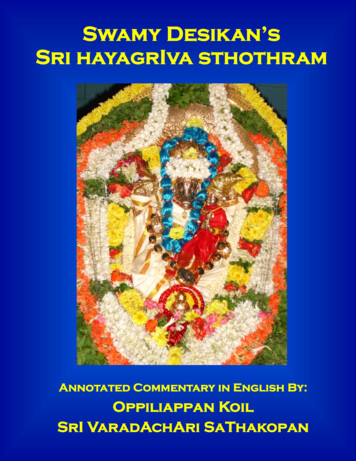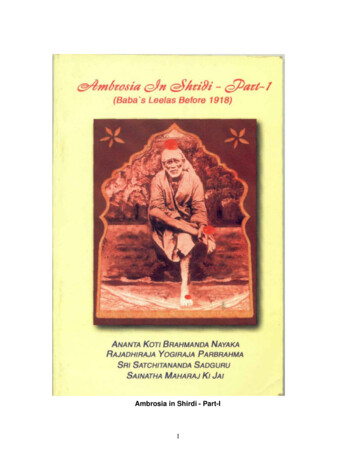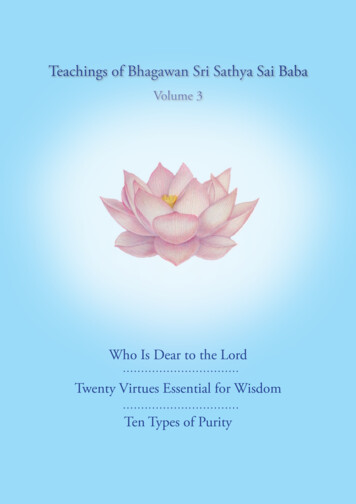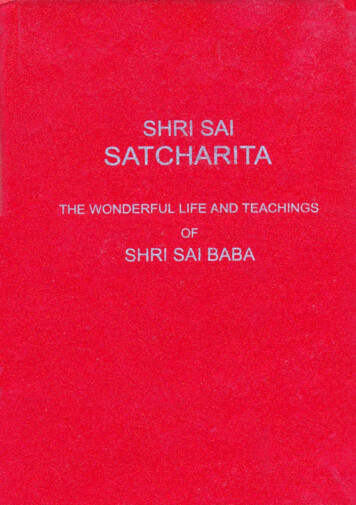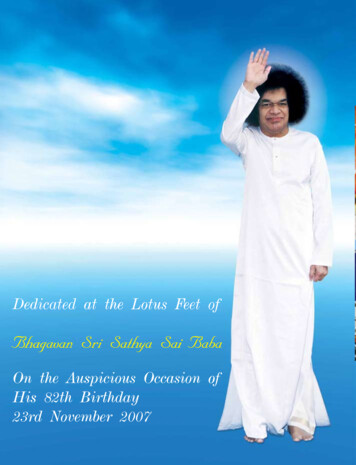
Transcription
Dedicated at the Lotus Feet ofBhagavan Sri Sathya Sai BabaOn the Auspicious Occasion ofHis 82th Birthday23rd November 2007
Arati being offered to Bhagavan in Poornachandra Auditorium where VedaPurusha Saptaha Jnana Yajna was performed.
Sanathana SarathiDevoted to the Moral and Spiritual Uplift of Humanity throughSATHYADHARMASANTHIPREMAAHIMSAVol: 50 Issue No. 11 Date of Publication: 10th NovemberNOVEMBER2007 Sri Sathya SaiBooks and Publications Trust,Prasanthi NilayamPrinted and Published byK.S. RAJANon behalf of the owner,Sri Sathya SaiBooks and Publications Trust,Prasanthi Nilayam 515 134,Anantapur District (A.P.),Printed at M/s Rajhans Enterprises,136, 4th Main Road, Industrial Town, RajajiNagar, Bangalore - 560 044, Karnataka.Published at Prasanthi Nilayam 515 134.E-mail: ssbpt.orgISD Code : 0091STD Code : 08555Telephone : 287375Sri Sathya Sai Central Trust Telefax : 287390General enquiry : 287164Sri Sathya Sai University Administrative Office : 287191 / 287239Sri Sathya Sai HigherSecondary School : 287522Sri Sathya SaiPrimary School : 287237SSSIHMS, Prasanthigram,Puttaparthi : 287388SSSIHMS, Whitefield,Bangalore : 080 28411500Annual SubscriptionEnglish or TeluguAcceptable for 1, 2 or 3 years.Inland : Rs 50/- (12 issues)Overseas: Rs 480/or U.S. 11 or U.K. 7 or 9Note: Please do not send currency notesin postal covers. For the Attention of“Sanathana Sarathi” Subscribers.The month and year of expiry of yoursubscription is indicated next to thesubscription number on the mailingwrapper. Three asterisk marks (***)appearing after your subscription numberindicate that you should renew yoursubscription immediately. Please quoteyour present subscription numberwhile renewing the subscription. Allsubscriptions and other correspondenceshould be addressed to The Convener,Sri Sathya Sai Books & Publications Trust,Prasanthi Nilayam 515 134.EditorG.L. ANAND“You are not separate from God. Youare an aspect of Mine. You shouldrecognise your relationship with God.This relationship is eternal. You maybelong to any religion, you may goanywhere, but this relationship with Godwill always exist. Hence, do not observeany differences whatsoever.”CONTENTSPublisher’s Note . . 363Fifty Years ofSanathana Sarathi – An Overview . . 364EditorialSuffuse all your Endeavours with Sathyaand Dharma. 371Vijaya Dasami DiscourseCelebrations at Prasanthi Nilayam . . 376A ReportAll Students should Serve Society. 384Divine Discourse 8 : Ati Rudra Maha YajnaPilgrimage to the Throne . . 391From our ArchivesNews from Sai Centres . 394Equanimity . 400Chinna KathaForthcoming Festivals at Prasanthi Nilayam19th November . Ladies Day22nd November. 26th Convocation of Sri Sathya SaiUniversity23rd November. 82nd Birthday ofBhagavan Sri Sathya Sai Baba
PUBLISHER’S NOTE“Now you have work at Puttaparthi . A monthly magazine will start soon .” thatwas how Bhagavan Baba recalled Kasturiji from All India Radio, Bangalore inthe 32nd year of His Avataric career. He also announced that He had decidedto designate it as “Sanathana Sarathi”. Dwelling on the purpose of this instrument born out of‘His Sankalpa’ Bhagavan said, “This Sarathi will fight for the firm establishment of peace in theworld; it will proclaim its victory through reverberating drum-beats. It will ensure, by its triumph,Ananda for all mankind.”The first edition of this unique magazine, the Inaugural Number, saw the light of the day onMahasivarathri in February 1958. It is unique not only in concept, but also in texture and spiritas it is enlivened by the breath of the Avatar of the Age. Not only He kept a close watch on itspublication, but He also reminded those connected with its editing and publishing even fifteenyears later that they have to propagate assiduously, unconcerned with decorative display andprofit-loss reckoning, the Integration of Human Race. The Lord conferred His Blessings on itsaying, “May Sanathana Sarathi reach its supreme fruition in Sarva-Jiva-Samaikya-Varidhi (AllBeings - Integral - Union - Ocean), the Goal of Awareness of the one, without a second.”“Sanathana Sarathi” has now covered fifty years of its glorious existence as the BhagavanUvacha (Thus Spake the Lord), i.e., as the mouthpiece of Prasanthi Nilayam, the Abode ofSupreme Peace. As foretold, during all these years, the “Sanathana Sarathi” acted as “thebridge which leads you to Me and brings Me to you.” It is no wonder, the magazine was receivedby devotees not as a periodic publication, but as “Prasadam” from the Divine.For several months in the beginning the magazine was, published as bilingual both in Teluguand English. Later on, they were printed separately. It made rapid strides in the past fewdecades and from a few hundreds its number of subscribers increased to several thousands– both in English and Telugu. It also serves as a prototype for its publication in eleven otherIndian languages, besides Nepali and eleven other overseas languages.It is a great honour and privilege for the Convener of the Book Trust to publish this specialissue of “Sanathana Sarathi” commemorating the golden jubilee year of the magazine on theoccasion of the 82nd Birthday of Bhagavan and prayerfully present the same at the Lotus Feetof our compassionate and merciful Lord for the benefit of our esteemed readers.– ConvenerSri Sathya Sai Books and Publications TrustNovember 2007363
EDITORIALFIFTY YEARS OFSANATHANA SARATHIIAn Overviewn a grand function held at Prasanthi Nilayam on 16th February 1958, theauspicious day of Sivarathri, Bhagavan Sri Sathya Sai Baba released the firstissue of “Sanathana Sarathi” through which He willed to convey His DivineMessage to mankind.In fact, the need for a magazine from Prasanthi Nilayam had been felt by thedevotees of Bhagavan since many years. It was not possible for even very ardentdevotees to come to Prasanthi Nilayam often, both because of the arduousnessof the journey and minimal facilities for stay that were available in those days.Puttaparthi was then a remote hamlet in a most backward and drought-proneregion of Andhra Pradesh, and was not linked by rail or road. Moreover, peoplefrom far-off places and overseas countries could not come here due to the expenseon the journey. The need for a magazine was therefore acutely felt by the devoteesin order to keep in touch with Bhagavan and His Message and to know aboutthe happenings at Prasanthi Nilayam. Many fervent prayers were made by thedevotees, but Bhagavan waited for an appropriate time to launch the magazine. Hehad already declared that His first 16 years would primarily show His Leelas (divineplay) and the next 16 years of His life will show Mahimas (glories), and thereafterHe would spend more time in Upadesh (teachings). He embarked upon His DivineMission to assume the role of World Teacher after 32 years of His life sojourn onearth. Thus started the era of His Upadesh (teachings) and “Sanathana Sarathi”was privileged to become the chief medium of Bhagavan’s teachings.Bhagavan clarified the purpose of starting this magazine in its very first issuewhich contained this historic declaration both in Telugu and English: “From thisday, our Sanathana Sarathi is on the march, at the head of its spiritual cohorts – theVedas, the Upanishads and other scriptures – to subdue injustice, viciousness,falsehood and licence, the minions of ego. May this Charioteer fight for worldprosperity and achieve victory! May it spread joy among all mankind!”Bhagavan willed “Sanathana Sarathi” to be a scripture like the Vedas and theUpanishads and other scriptures of the world. It is, of course, a source of solace,peace and illumination for its readers like all scriptures. But it is different from otherscriptures in two ways. First, it is a scripture that has not been labelled as Hindu,Christian, Muslim, etc. Rather, it is a scripture for the followers of all the religionsof the world because it preaches an altogether different religion – the religion of364November 2007
love – which binds all mankind into one. Secondly, it is a scripture which is being handed out tomankind by Living God. It is therefore no wonder that the readers of “Sanathana Sarathi” find inthe printed words of Bhagavan Sri Sathya Sai Baba a divine energy which overwhelms, elevates,enlightens and transforms them. Millions of them during the last 50 years have vouchsafed thatreading of “Sanathana Sarathi” is an extraordinary experience.The very name “Sanathana Sarathi” specifies its purpose. In fact, Bhagavan Himself isSanathana Sarathi, the Eternal Charioteer of man. In a world afflicted by greed, selfishness,hatred, cruelty and violence, this Avatar has come as the Eternal Charioteer of mankind tosteer it on the path of Sathya, Dharma, Santhi, Prema and Ananda for the moral and spiritualregeneration of the world. He has stated this truth clearly in one of His beautiful Telugu poemswhich reveals His identity to mankind:Considering what qualities Lord Vishnu had gone to save His illustrious devotee Prahlada;Considering what qualities the Lotus-eyed Lord had gone to protect the elephant, Gajendra;Considering what qualities the Vaikuntha Vasi (dweller of Vaikuntha) Lord Vishnu had takeninto His fold the child devotee, Dhruva;Considering what qualities Lord Vishnu who is extolled by the Vedas showered His grace onpoor Kuchela suffering from abject poverty;Considering the same qualities, the Lord who is adored by the immortal gods has incarnatedas Sathya Sai in Puttaparthi to protect and foster the afflicted and suffering people in this world.He is Anathanatha (the Lord of the forlorn), He is Srinatha (the Lord of wealth and prosperity),He is verily Satchitanandamurthi (the embodiment of existence, knowledge, bliss).This forthright declaration of Bhagavan coupled with actual transformation of millions ofpeople all over the world as documented and recorded in numerous books, magazines, films,etc., reassures mankind that He is the same Lord of the universe, who removed the veil ofignorance of Arjuna and showed him the path of redemption through the immortal knowledgeof the Bhagavadgita, which has provided succour and light to generations of humanity. The last50 years of the experience of the readers of “Sanathana Sarathi” reveals that it is the samewisdom, power and illumination that is contained in the pages of “Sanathana Sarathi”. LordKrishna promised:Yada Yada Hi Dharmasya Glanir Bhavati Bharata,(Sanskrit Verse)Abhyutthanamadharmasya Tadatmanam Srujamyaham.(Oh Arjuna! Whenever there is a decline in Dharma and rise in Adharma, I incarnate for theestablishment of Dharma.)Bhagavan reaffirms this declaration of Lord Krishna in His following Telugu poem:In order to set right the distorted rules of the Age,To purify the spoiled conditions of all the worlds,To protect the depressed saints having been downtrodden by the wicked,To clarify the hidden truths of the commentaries of the sacred books,To relieve the enormous burden of Mother Earth,November 2007365
To fulfil the boons given in Treta Yuga,The immortal Supreme Lord has descended on the earth as the Embodiment of Truth,Whom you can see in Puttaparthi now.The word Sanathana indicates that God has always performed this role of the charioteer ofmankind in all Ages since the dawn of history. But man must invite the Lord to take the reins ofthis chariot. As Bhagavan says, “The individual must install himself in a chariot with the wheelsof detachment and truth. The Lord will then accept the position of the charioteer. He will hold thereins (mind) and direct the horses (senses) straight and safe over the road (the path of salvationthrough self-realisation).” Significantly, the cover page of the very first issue of this magazine hadthe picture of Lord Krishna as charioteer holding the reins of the horses of the chariot of Arjunato reaffirm the appropriateness of the name of the magazine as “Sanathana Sarathi”.Bhagavan sometimes makes very stupendous declarations during ordinary conversations.He revealed His Sankalpa (Will) to launch this monthly magazine and name it Sanathana Sarathiduring one such conversation with Prof. Kasturi, the first editor of “Sanathana Sarathi”. In hisinimitable style, Prof. Kasturi narrates this incident in his book “Loving God”. It will be interestingto hear the story from him in first person:“I got the good news pretty quick; Baba had come to Bangalore. He was staying in Sri VittalRao’s house on the 9th Cross Road, Wilson Gardens, only 5 minutes away from my residence,“Ashoka” on the 12th Cross. Knowing that there was a possibility of His coming to his place, Ihad tipped the dry cleaner, who attended to the washing and ironing of his door and windowcurtains, to inform me as soon as he delivered the wash to Vittal Rao. I had noticed that hehad the curtains washed and ironed as part of house‑cleaning, preliminary to Baba’s visit.When the news leaked at last, I posted the little daughter of my domestic help on a slab ofstone facing his house, with directions to keep watch for a big car and an orange robe. Sowithin ten minutes of Baba’s stepping into his house, Vittal Rao was amazed to find me onhis verandah! “Wait! Wait!” he pleaded. But Baba spotted me and came towards me with Hispalm ready to fall on my shoulder. “Now, you have work at Puttaparthi”, He said. “A monthlymagazine will start soon. Guess! How is it named?” He asked. I confessed I could not delveinto His Will. Yet He drew out from my reluctance a few names: “The Godward Path,” “KarmaDharma .” “Premayoga.” He waved aside the titles I suggested and announced that he haddecided to designate it as Sanathana Sarathi!”That name is a clarion call. “Recognise God as the Sarathi, yield wholeheartedly to Hisdirection, reach your Destination in good shape”, was the message Baba was conveyingthrough that name. I was elated, elevated.”The first issue of the magazine was printed at a press in Dharmavaram. Later when Bhagavanvisited Bangalore, He Himself went to Vichara Darpana Press on Avenue Road along with Prof.Kasturi and Raja Reddy and bought a foot-operated treadle printing machine which had 14-inchdiameter plate on which two pages of the magazine could be printed at a time. Bhagavan alsobought a case each of Telugu and English types and the other necessary equipment to set up366November 2007
a printing press at Prasanthi Nilayam, which was to be named Sri Sathya Sai Press. The presswas set up in a small room at the eastern end of what was earlier called Pathashala block. In1973, it was shifted to Brindavan, Whitefield (Bangalore) and was named Vraja Brindavan Press.In the year 1986, the press was shifted back to Prasanthi Nilayam and was set up at a placewhere now stands Junior Boys Hostel. In the year 1994, it was shifted to its present location.An old devotee named Narsimhachari handled composing and printing. The entire work of themagazine was shared by Prof. Kasturi and Narasimhachari between themselves. Prof. Kasturiwas a versatile genius. He translated Bhagavan’s Telugu articles into English, read and correctedproofs, enlisted subscribers, maintained the register of subscribers, pasted the addresses on thecovers, took the uncut copies to Bangalore, brought them back after cutting and posted themon the due date. He was a translator, proof reader, circulation manager and even postmasterfor some time – all rolled into one. The magnitude of the work done by Prof. Kasturi can beestimated from the following description given by him:“For about a year, Narasimhachari, the sole helper at the treadle, put together the types,prepared the pages and pedalled away, to get two pages printed at a time. I offered to helphim in the composing and in the footwork when I found him delaying or dozing. I was shockedwhen he accepted the offer whenever I made it! The job was really hard, though he lightenedand brightened it singing Bhajans to himself.“I was kept busy most of the day and even a few hours of the night, since the number ofsubscribers increased fast. Money was sent by post or paid direct by devotees and pilgrimswho realised that the Sarathi was the link between the Chariot and the Charioteer. The registerof subscribers became more voluminous with every festival at Prasanthi Nilayam; thousandswho came to the holy Presence mired to ensure that the voice of the Lord should enter theirdoors at least once every month.For over two years, I and Narasimhachari bore the yoke. We were anxious to post the numbersat the newly opened Prasanthi Nilayam Post Office on the 16th of every month as announcedin the very first copy. Devotees, we knew, would welcome it even more reverentially whenthey find, on the wrapper, on the right hand corner, the circular frank‑mark of the Post Officewith the euphoria‑filled name Prasanthi Nilayam. But a cutting machine which could trim theedges of the magazine was acquired only much later, long after a cylinder press was installedto cope with the 3000 copies we had to print. They had to be trimmed at Bangalore City, 100miles away.”Prof. Kasturi performed this arduous journey, using all possible modes of transport – bullockcart, bus, horse-drawn carriage and train – so as to post the magazine on the 16th of everymonth. For many months, “Sanathana Sarathi” was bilingual and contained both English andTelugu matter. Bhagavan was its main contributor. Every month, He specially wrote an article for“Sanathana Sarathi”. In the very first issue, the first article was given by Bhagavan, which wasa part of series of articles proposed to be made later into a book, to be named “Prema Vahini”.Every month, Prof. Kasturi went to Bhagavan to collect this hand-written article of Bhagavan inTelugu, which he translated into English and put both Telugu and English versions of Bhagavan’sarticle in the same issue. Bhagavan continued contributing His monthly article for “SanathanaNovember 2007367
Sarathi” every month from its first issue in February 1958 up to October 1984 for 26 long yearswithout any break. This in itself is a stupendous work if we see merely its magnitude. Thesearticles were later compiled into 16 books, popularly called Vahini books.But that is not all. Even more important is the quality of the articles written. Written in simpleand spoken Telugu, they capture the attention of the reader by their direct style which can becalled conversational. Their uniqueness lies in the fact that they are simple and easy to grasp,yet they contain depth of meaning like that of the Vedas and the Upanishads. The deepestVedantic truths therefore get explained in these articles in the easiest language without pedantryand show of scholarship to the benefit of both a layman and a scholar. This is the main reasonwhy these Vahini books have universal appeal and have been translated into almost all thelanguages of the world. However, the most remarkable fact about these books is that they havenot been written after reading other books. They flowed from Bhagavan’s heart as naturally andeffortlessly as His breath.Bhagavan does not need to consult any book to pen authoritative commentaries on thecontents of the Vedas and Upanishads, yet the novelty of His interpretation and depth of Histhought astonish all scholars. Prof. Kasturi describes his first-hand experience of Bhagavan’sway of writing. Let us hear from him his experience when once he went to Bhagavan to receivethe article which Bhagavan wrote for “Sanathana Sarathi” every month:“Baba has declared more than once that the revival of Vedic studies and research, withthe aim of reviving the practice of Vedic ideals, is one of His plans for rehabilitating man.Baba, therefore, decided on a small book on the Upanishads, in order to rivet the attentionof the world to the efficacy of Vedanta. As editor of the magazine which published seriallythe chapters of this book, I had an amazing experience every month for a whole year. Afterdespatching the magazine on the 16th of the month, I would go to Him for the next part ofthe series. Announcing the name of the Upanishad Himself, He would ask me to wait for awhile in His room and proceed along the verandah with a notebook and pen, towards theroom where there stood a table with a chair by its side and nothing else besides. Once, itwas the turn of the Brihadaranyaka Upanishad to be summarised and simplified. It is thebiggest and the profoundest of the ten. I am certain that Baba had never read it or consultedothers who could talk on it. And there was no copy available anywhere within miles. But fortyminutes after He moved out with the pen and the notebook as His sole possessions, I coulddescend the eighteen steps from His room with a ten-page dissertation on the truths thisUpanishad enshrined! I peeped into the script as I walked towards the press and my eyesfell on the Telugu words which said, ‘The grandeur of the intellect of the Sage Yajnavalkya isimpressively evident in this Upanishad.’ I told myself, it is now impressively evident to me.”All the 16 Vahini books were penned by Bhagavan in a most effortless and natural mannerwithout referring to any book whatsoever. Similar is the case with His Discourses which flowas naturally from Him as His breath. These Discourses and Vahini books are verily the Vedasand the Upanishads, the divine knowledge of which Bhagavan in His compassion is impartingdirectly to modern man in the same manner as the Supreme Being whispered the knowledge ofthe Vedas to ancient Rishis.368November 2007
The spontaneity of His writings coupled with richness of the message given through thesearticles of various books had such a captivating effect on the readers that the number ofsubscribers rose from a few hundreds to many thousands in a short time. Along with thesearticles of Bhagavan, excerpts and summaries of His Discourses also started finding place in“Sanathana Sarathi” within a year of its publication under such headings as “Life Pilgrimage”,“The Bhagavadgita”, “Upadesh Panchamritam”, “Sathya Sai Sweeties” and “Sathya SaiBaba Speaks”. The first full length Discourse of Bhagavan appeared in August 1961 issue of“Sanathana Sarathi” under the heading “Inner Temple”, which was Bhagavan’s Discourse givenat Bukkapatnam on 18th July 1961. Detailed summary of Bhagavan’s Dasara Discourses findsplace in November and December 1961 issues under the title “Mathura Nagar this Puttaparthi”.Though Bhagavan gave informal talks on the sands of Chitravathi and various other placesbefore small groups of devotees, He delivered His first public Discourse during Dasara celebrationsat Prasanthi Nilayam in 1953. The spontaneity and freshness that marks Bhagavan’s writingsis seen in His Discourses also. Delivered in conversational Telugu in a style that is informaland intimate, Bhagavan’s Discourses are embellished with interesting anecdotes, illuminatingparables, Sanskrit verses from scriptures and charming Telugu lyrics, most of which are selfcomposed and blossom on His tongue instantaneously. In fact, almost all His Discourses beginwith a sweet lyric and conclude with a Bhajan; both of which cast a spell on the listeners as Hesings these in His golden voice. The icing on the cake are His dazzling poems, epigrams, similes,metaphors and acronyms, which illustrate the deepest spiritual truths in a flash of illumination.These embellishments are used so artistically that they do not diminish the shine of His Message.Rather, they enhance the clarity, comprehension and grandeur of His Message so that it ispermanently imprinted on the hearts of the listeners and readers. As His Discourses directlycome from His heart and do not have even a trace of artificiality, they are always fresh andcharming. The bulk and variety of His Discourses can be estimated by referring to “Sathya SaiSpeaks” which runs into nearly 40 volumes at present. Another uniqueness of these Discoursesis that they are as captivating and enrapturing today as they were six decades ago. It is thereforeno surprise that hundreds of thousands throng to listen to them when they are delivered and readthem with avidness and reverence when they appear in printed form in “Sanathana Sarathi”.Since 1984, when Bhagavan concluded the writing of Vahini series articles with the 8th articleof “Leela Kaivalya Vahini”, His Discourses in “Sanathana Sarathi” have become the chief mediumof Bhagavan’s message to mankind. This magazine which is now being printed in 25 Indian andoverseas languages has subscribers in almost all the countries of the world who read it withreverence like any other scripture. Most of them consider that coming of “Sanathana Sarathi”in their house is as good as coming of Bhagavan Himself as the word of God is God Himself.It is difficult to find another spiritual magazine which has such a large number of subscribers inall parts of the world and which is being published every month in so many languages of theworld.Bhagavan willed “Sanathana Sarathi” to be a purely and uncompromisingly a spiritualmagazine to convey to mankind His message of love, unity and peace so as to bring joy, solaceNovember 2007369
and harmony in their life. Therefore, conspicuous by its absence in this magazine is the businessmotive which distinguishes Bhagavan’s all endeavours from others. In the very first issue inFebruary 1958, it was announced: “No commercial advertisement will be published in thismagazine.” Bhagavan has always advised those who were assigned the work of editing andpublishing the magazine to concentrate on conveying His message of truth and love to the worldwithout any profit-loss reckoning.It is the great good fortune of the contemporaries of this Avatar that they are not onlyreceiving His Divine Message directly from Him, but are also witnessing with their eyes howHe has demonstrated His teachings in His own life. His life is the shining example of Sathya,Dharma, Santhi, Prema and Ahimsa and all His teachings. But this is not all. He has set up manyinstitutions and started various projects to illustrate to the leaders of the world how ideals canbe converted into reality to create a world saturated with love, peace, unity and harmony. Hiseducational institutions, for example, practically show to the world that the end of education ischaracter. Similarly, His hospitals present the ideal of free quality healthcare for all in practicalform. His drinking water projects and several other social welfare schemes show the ideal ofselfless service to man. Prasanthi Nilayam set up by Him demonstrates to the world the idealof Brotherhood of Man and Fatherhood of God where people of all religions, nationalities andraces live in an atmosphere of unity, love and peace as one race of humanity. In the same way,“Sanathana Sarathi” presents a shining beacon of light to show to the world media how it canperform its duty of teaching noble ideals to mankind without any commercial considerations.“Sanathana Sarathi” has not only been a powerful source of support, succour and happinessin the lives of millions of its readers in all parts of the world belonging to all nationalities, racesand faiths, but it has more importantly elevated, enlightened and transformed their lives duringthe last 50 years. The unique role played by it for the redemption of mankind has hardly anyparallel in the spiritual history of the world. On the golden jubilee of “Sanathana Sarathi”, I mosthumbly convey deep gratitude to Bhagavan on behalf of millions of its grateful readers for givingthis divine magazine to modern man for his ethical and spiritual uplift.– Editor370November 2007
AVATAR VANIVIJAYA DASAMI DISCOURSESUFFUSE ALL YOUR ENDEAVOURSWITH SATHYA AND DHARMAVijaya Dasami is a festivalwhich is celebrated by all. But tosome it brought sorrow, because itwas on the Vijaya Dasami day that ‘old body’(of Shirdi Sai Avatar) was given up. Humanbody is, of course, physical and temporary.Spiritual Practices are Useless withoutSathya and DharmaOnce when Laxmibai came to Shirdi SaiBaba, he told her, “Laxmibai! Keep these twocoins with you. These are gold coins.” (Whilenarrating this incident, Bhagavan materialisedtwo gold coins and showed these to devotees).These two coins symbolise Sathya andDharma which help man to progress on thepath of spirituality. Swami often sings the song,“Sathya Dharmamu Santhi Premalato NeeNitya Jivana Yatra Saginchu” (Perform thejourney of your life adhering to the principlesof Sathya, Dharma, Santhi, Prema). Sathya isAtma. To follow Dharma is our duty. Therefore,follow Dharma strictly adhering to Sathya.These two constitute the true spiritual practice.They will safeguard you in every way. They willrelieve you of all your sorrows, miseries andIf we give prime importance to Sathyaand Dharma in our life, they willnot only sustain us, they will alsoprotect the whole world. We adoptso many methods for the welfare andprotection of the world. But all theseare artificial. The real means areSathya and Dharma. Keep them withyou always day and night, and installthem in your heart. You limit Sathyaand Dharma merely to your speech.No, no. You should imprint them onyour heart. Only then will they giveyou the desired fruits.November 2007371
difficulties. Since that day, Laxmibai kept thosetwo coins with her. She thought, “These are thecoins given by Baba. These are made of goldand are more valuable than even diamonds.There is nothing that is more valuable thanthese. I do not want anything else exceptthese because these represent both Sathyaand Dharma.”Man should not deviate even a bit fromthe path of Sathya and Dharma while leadinga worldly life. If we have Sathya in our heartand Dharma i
Bhagavan Sri Sathya Sai Baba On the Auspicious Occasion of His 82th Birthday 23rd November 2007. Arati being offered to Bhagavan in Poornachandra Auditorium where Veda Purusha Saptaha Jnana Yajna was performed. . It is a great honour and privilege for the Convener o
